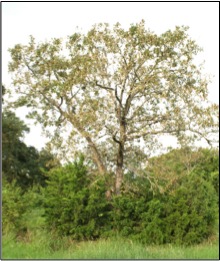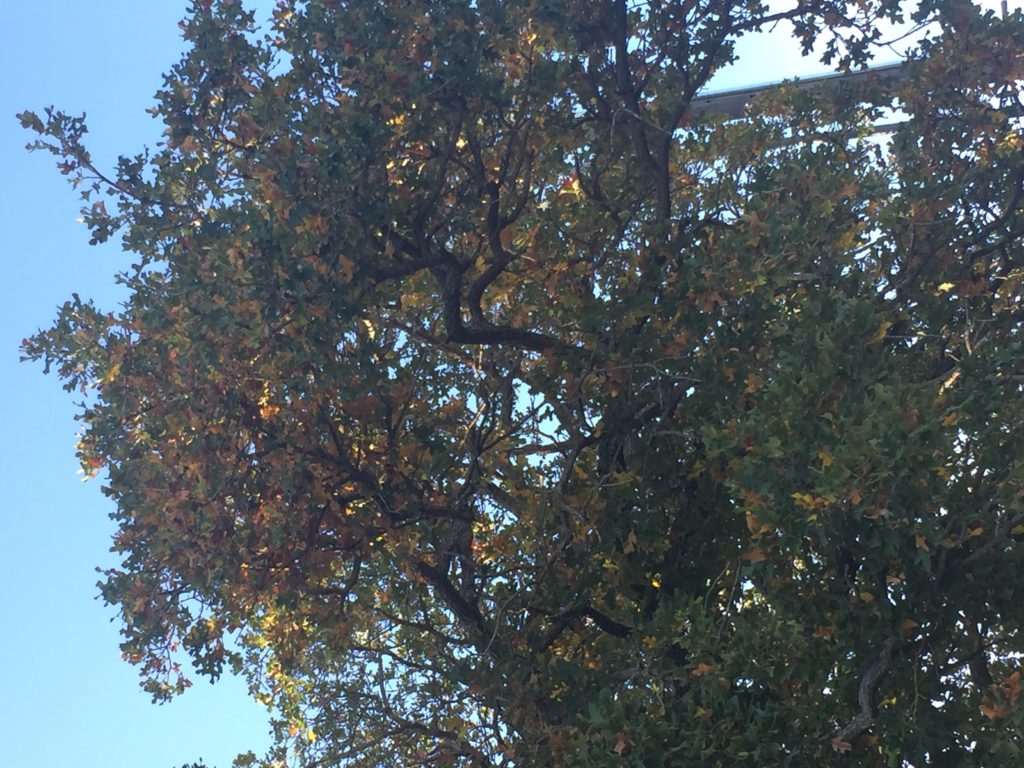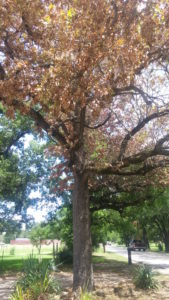Ms. Sheila McBride (TPDDL diagnostician) and Dr. David Appel, Extension Plant Pathologist with the Texas A&M AgriLife Extension Service contributed this article to address the numerous inquires that has been received this year regarding declining oak trees -KO

This year, beginning in the early spring to late summer, there has been many inquiries as to why the post oaks have “suddenly” died. The most frequent symptoms have been described as a rapid appearance of chlorotic (yellow) and/or necrotic (brown and dead) leaves throughout the entire crown. The leaves often remain attached on the twigs, but the trees are dead. Another, alternative scenario has the leaves dropping off to produce a tree with sparse foliage and thin canopies. These latter trees are lingering with various stages of twig and branch die back, but are still alive.

Dying or dead leaves on Post Oak
We believe this phenomenon of rapid decline of the post oaks is a result of varying extremes of soil moisture (drought and/or drowning) leading to attack by root rots, cankers, and wood boring insects. Root rot can develop as a result of saturated soils (poor internal soil drainage) resulting in inadequate oxygen diffusion to the tree’s root system. All of these problems were made worse by the historic drought of 2011 when the health of these trees was crippled to such an extent that they are still suffering today. Extreme  drought causes trees to cope with the drought stress and expend the storage carbohydrates they normally depend on to grow, reproduce and defend themselves against pests and diseases. The heavy rainfall during the spring of 2016 combined with the poorly drained soils where we are seeing the death of post oaks is contributing to their demise. Post oaks are intolerant of “wet feet”!! Simply put, trees get stressed too, and then they are unable to defend themselves. We are confident the cause of the death of post oaks is NOT oak wilt. The same sorts of oak declines have been observed world-wide, where research has verified the same patterns and causes as those we have seen in the in Texas post oak mortality problem.
drought causes trees to cope with the drought stress and expend the storage carbohydrates they normally depend on to grow, reproduce and defend themselves against pests and diseases. The heavy rainfall during the spring of 2016 combined with the poorly drained soils where we are seeing the death of post oaks is contributing to their demise. Post oaks are intolerant of “wet feet”!! Simply put, trees get stressed too, and then they are unable to defend themselves. We are confident the cause of the death of post oaks is NOT oak wilt. The same sorts of oak declines have been observed world-wide, where research has verified the same patterns and causes as those we have seen in the in Texas post oak mortality problem.
http://agrilifelearn.tamu.edu/Hypoxylon-Canker-of-Oaks-p/eplp-030.htm). Obviously, in woodlands these practices are not feasible. We simply have no measures to reverse the impact of environmental stress and subsequent attack by contributors such as diseases and pests to tree death.
STAY TUNED IN FOR MORE EXTENSIVE INFORMATION AND PHOTOS!
UPDATE! EPLP-033 factsheet ” Rapid Decline of Post Oaks” is now available on the AgriLife Bookstore.
http://agrilifelearn.tamu.edu/Rapid-Decline-of-Post-Oaks-in-Texas-p/eplp-033.htm


